Larissa Nowicki
The Event of Making: Uncovering Alternative Modes of Communication in the Work of Anni Albers
Summary
This research investigates Anni Albers’s essays through a conceptual practice-led approach to textual analytics and discourse analysis. The visual artist / researcher engenders new readings of Albers’s essays through the experience of making with materials opposed to traditional qualitative methods of historical discourse analysis (Smith and Dean, 2014). Practice-based methods, grounded in contemporary fine art making, are constructed according to Albers’s creative practice and informed by “thinking through doing” philosophy (Ingold, 2013). Performed by hand and dependent upon embodied knowledge, each episode of making is a charged event, an experiment to test Albers’s concepts while observing what new ideas and questions emerge to drive the research forward. Each art project, with its nuances and insights, represents an engagement with the materiality of ideas.
Most recent scholarship on Anni Albers reiterate what we already know about Albers as textile designer, artist, and contributor to Media and Communication fields. This research, through modes of making, reads against the grain of dominant paradigms in historical research by considering what is absent in Albers’s text. Silence, unto itself may operate as a mode of communication (Wolff, 1992). As this research unfolds it implicitly answers the question: What value and privilege does embodied knowledge maintain as direct interaction with the material world wanes in exchange for broader experiences via new technologies within digital environments? As this research is performed through processes which are traditionally considered gendered and marginalized as women’s work (i.e. weaving, sewing, textiles) it draws from a material based non-linguistic form of communication, in effect subverting the dominant approach to writing art history (Bristow, 2016, p.8). By departing from an adherence to the original language and meaning in Albers’s texts, this research releases itself from the linguistic limitations encountered through traditional historical research. By looking outside of Albers’s loom and beyond the margins of her texts, I argue there is still more to discover in Albers’s modern art and design repertoire.
Bristow, M. (2016). Pragmatics of Attachment and Detachment: Medium (un)Specificity as Material Agency in Contemporary Art. Ph.D. Thesis, Norwich University of the Arts and University of the Arts London.
Ingold, T. (2013). Making: Anthropology, Archaeology, Art and Architecture. Abingdon: Routledge.
Smith, H., Dean, R. T. (2014). Practice-Led Research, Research-Led Practice in the Creative Arts. Edinburgh: Edinburgh University Press.
Wolff, J. (1992). Feminine Sentences: Essays on Women and Culture. Oakland: University of California Press.
Additional info
Research Methodology: An Iterative Process of Practice.
This practice led research is conducted through a multi-method approach to doing qualitative research. The visual artist as researcher is situated at the centre of the investigation and performs the research through an iterative process in order to arrive at new interpretations of Anni Albers’s essays. The research is dependent upon the visual artist’s situated knowledge of practice and their subsequent interpretations of the text via their methods of creative practice and their subjective epistemology. This differs from the traditional research methodologies that typically begin with defined research questions and alternatively relies on the primacy of practice (Haseman and Mafe in Smith and Dean, 2014). Practice-led research executed within a cultural framework and reliant upon embodied knowledge and material mediations is rooted in the works of practice theorists, John Dewey, Art as Experience,1934 and Donald Schön, The Reflective Practitioner, 1983.
To begin, the researcher goes “back to zero” in much the same way Albers instructed her students at Black Mountain College to start their experimentation from the point of view of an amateur’s inquisitiveness (Molesworth, 2015). Albers’s creative process correlates with contemporary practice-led research in art and design which often begins from a “space of not knowing” (Fortnum, 2013) and as a “self-motivated enquiry” (Grocot in Wood and Haylock, 2020) through material experimentation and play. The first art projects in this research are constructed in response to the initial reading of On Design (Albers, 2000) and On Weaving (Albers, 2017) and serve to apply and test an Albers based model for creative practice within this research project. The visual artist / researcher continues to return to the Albers essays and conduct subsequent readings of her texts for purposes analogous to traditional hermeneutics. Looking, listening, experimenting, reading, writing, making become the methods for understanding and interpretation of Albers’s texts in two ways. First, to create a foundation of knowledge — an understanding of Albers’s original meaning and intent written in response to the social, political, and cultural contexts of her time. Second, as a way to interpret Albers’s theoretical principles in practical application to contemporary issues encountered by the visual artist / researcher of today.
Albers, A. (1961). On Designing. Middletown: Wesleyan University Press.
Albers, A. (1965). On Weaving. Middletown: Wesleyan University Press.
Fortnum, R. (2013). On Not Knowing: How Artists Think. London, UK: Black Dog Publishing.
Molesworth, H. (2015). Leap Before You Look: Black Mountain College 1933–1957. New Haven: Yale University Press and the Institute of Contemporary Art / Boston.
Smith, H., and Dean, R. T. (2014). Practice-Led Research, Research-Led Practice in the Creative Arts. Edinburgh: Edinburgh University Press.
Wood, L., and Haylock, B. (2020). One and Many Mirrors: Perspectives on Graphic Design Education. London: Occasional Papers.
Researcher Biography
Larissa Nowicki is a visual artist and researcher. Currently she is Ph.D. candidate at the Royal College of Art, London where she holds an MA in Communication Art and Design. She holds a BA in Graphic Design from Rhode Island School of Design. Her practice-led research is performed through gendered processes, which have long been associated with marginalized communities (i.e. weaving, sewing). Her research draws from material based non-linguistic forms of communication to develop alternative methods for expanding feminist scholarship within art history. Nowicki's artwork is held in both private and public collections.
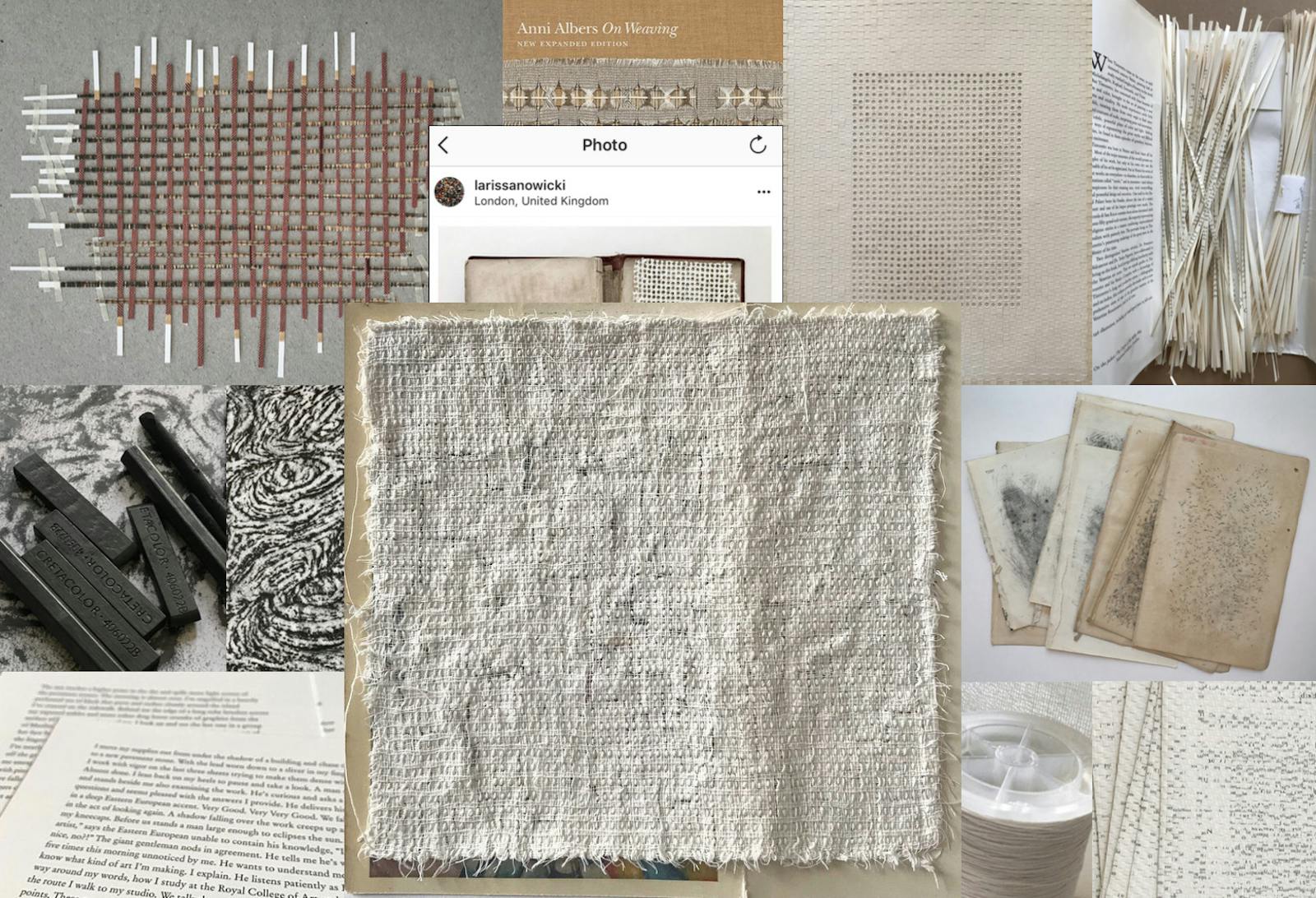
Review of Practice
Anni Albers’s (b.1899–d.1994) practical and theoretical concepts abound with relationships of duality—warp and weft, front and back, internal structures and external surfaces, hand-made versus mass produced, art and design, student and teacher. Albers merges contrasting thoughts or ideas in her writing much like weaving where the vertical threads (warp) are combined with the horizontal threads (weft). According to Albers there was no difference in being a designer or being an artist, it’s only a matter of one’s choices in process and intent and the outcome they produce. “Regardless of the material and the method of working it, designing is or should be methodical planning—whether of simple or intricately organised forms—and if done imaginatively and sensitively, designing can become art” (Albers, 2017). Primarily this research is an investigation into the relationship between practice and theory and how making within a contemporary fine art context can provide alternative methods for research outcomes. Specifically, how practice-led material engagement and reflective analysis within communication research can serve as an experimental alternative to traditional research methods. Alongside this research a personal narrative has emerged which is the story of my experience in working with Anni Albers through my interpretation of the text and her voice within the essays.
The following series of projects function as exercises in listening to Albers (as if in conversation with her). The practice components of this research are not intended in any way to mimic or copy Albers’s modernist aesthetic nor is everything she has written accepted without critique. In these projects, the visual artist / researcher is always concerned with what is happening in the process rather than contextualisation of final artefacts. The process of art and design become the driving force of the research (Frayling, 2015); and in this case, a rupturing event. The practice allows the visual artist / researcher to figuratively and literally break the binding of On Designing and draw Albers’s text out of history into a contemporary engagement to see how it all plays out.
Albers, A., Weber, N. F., Cirauqui, M., Smith, T. L. (2017). Anni Albers: On Weaving: New Expanded Edition. Princeton: Princeton University Press.
RTD Conference Series. (2015). “Provocation by Sir Christopher Frayling, Parts 1–7” in a film by Abigail Durrant and James Price for Research Through Design. Available at: https://vimeo.com/129775325 (Accessed: 25 August 2019).
Documentation and Reflexivity

(above) Begin the Begin, Ph.D. Research, First Year, Autumn Term, 2017
This was the messy start to my practice-led research. I was going on gut instinct and a trust in something I could not quite name. I re-read Anni Albers and wrote in the margins of her books, and filled new notebooks with word for word transcriptions of her essays—as if I could absorb the meaning by writing her words in my own hand. Finally in a moment of frustration I went back to my practice. I cracked the spine of my new copy of On Weaving and pulled out the colour plates. Then, I began to weave her weavings without a clue of what I was trying to discover or communicate. In this moment I was testing and learning to listen.
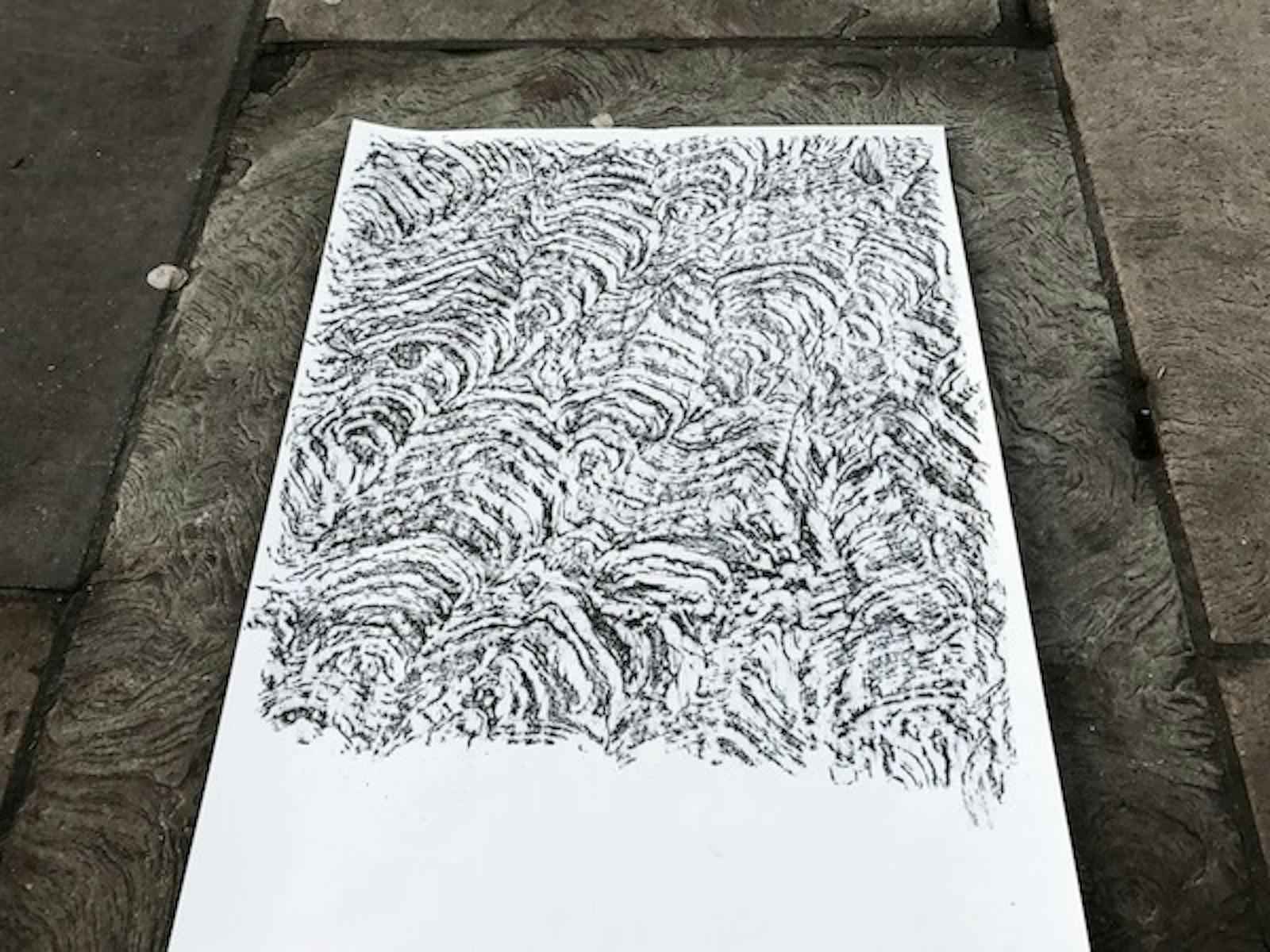
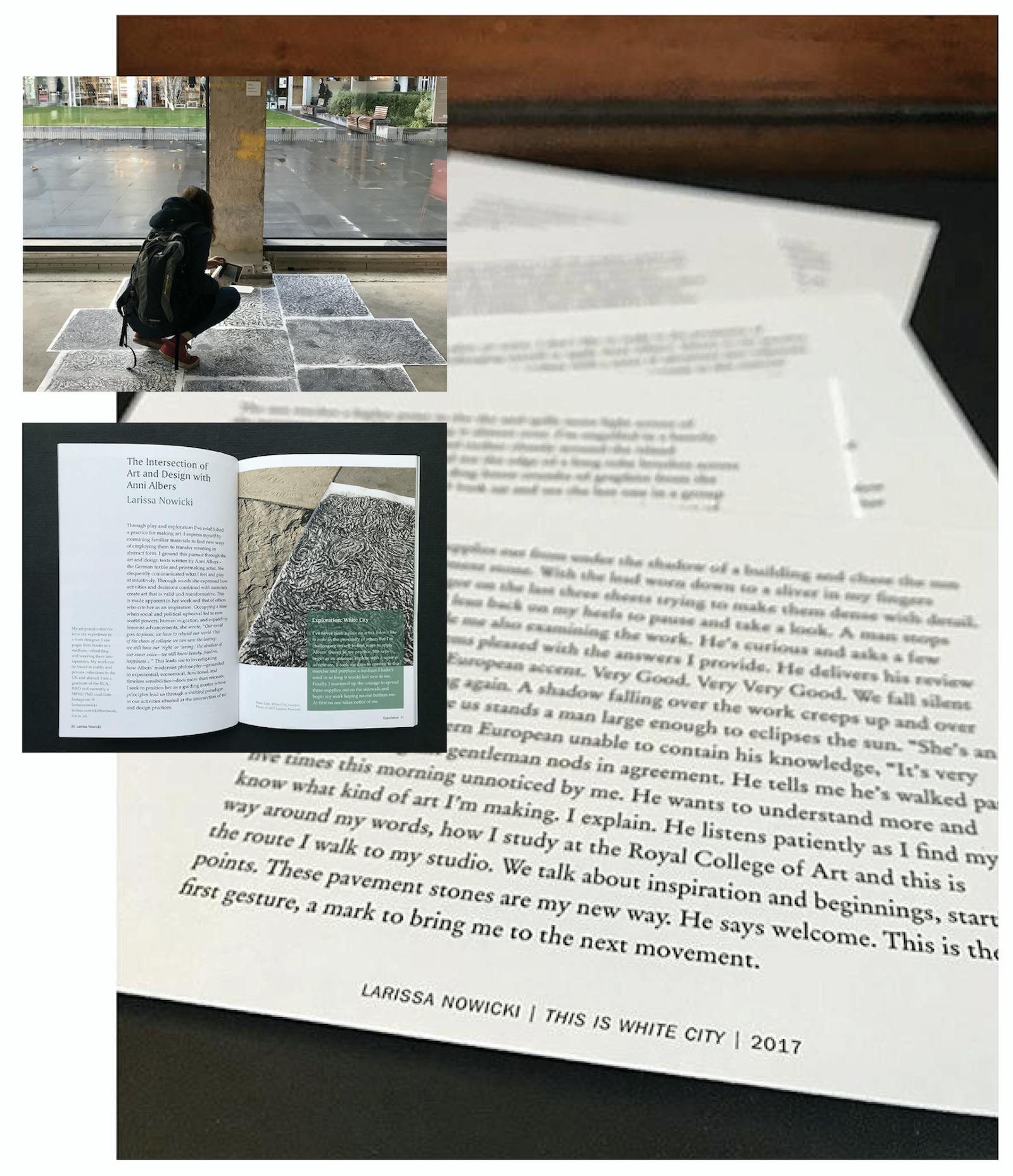
(above) This is White City, Ph.D. Research, First Year, Autumn Term, 2017
On Designing—Where and How to Start?
In order to establish a research method based in fine art practice I referred to Albers’s book Selected Writings on Design.
“We have to work from where we are. But just as you can go anywhere from any given point, so too the idea of any work, however small, can flow into an idea of true momentum.” –Anni Albers ‘On Jewelry,’ Black Mountain College, 1942 in On Designing
I began where I was, outside the tube station near the Royal College of Art’s new opened White City campus. Setting up outside on the sidewalk, using materials that I did not normally work with, and making charcoal rubbings of the textures in the pavement stones was my attempt at trying something outside of my familiar art practice. This was my personal journey back to zero, to begin my exploration from the position of the novice.
This project eventually became my submission for The RCA School of Communication’s research work-in-progress show, Intentions: Conversations, Experiences and Knowledge, December 2017. I chose to exhibit this work as an installation in which the audience was invited to experience the work from an unexpected perspective. In order to reach informational postcards, visitors had to physically enter the space by walking across the artwork. Their footsteps smudged the unfixed charcoal and left traces of their presence as unsuspecting disruptors and collaborators in the work.
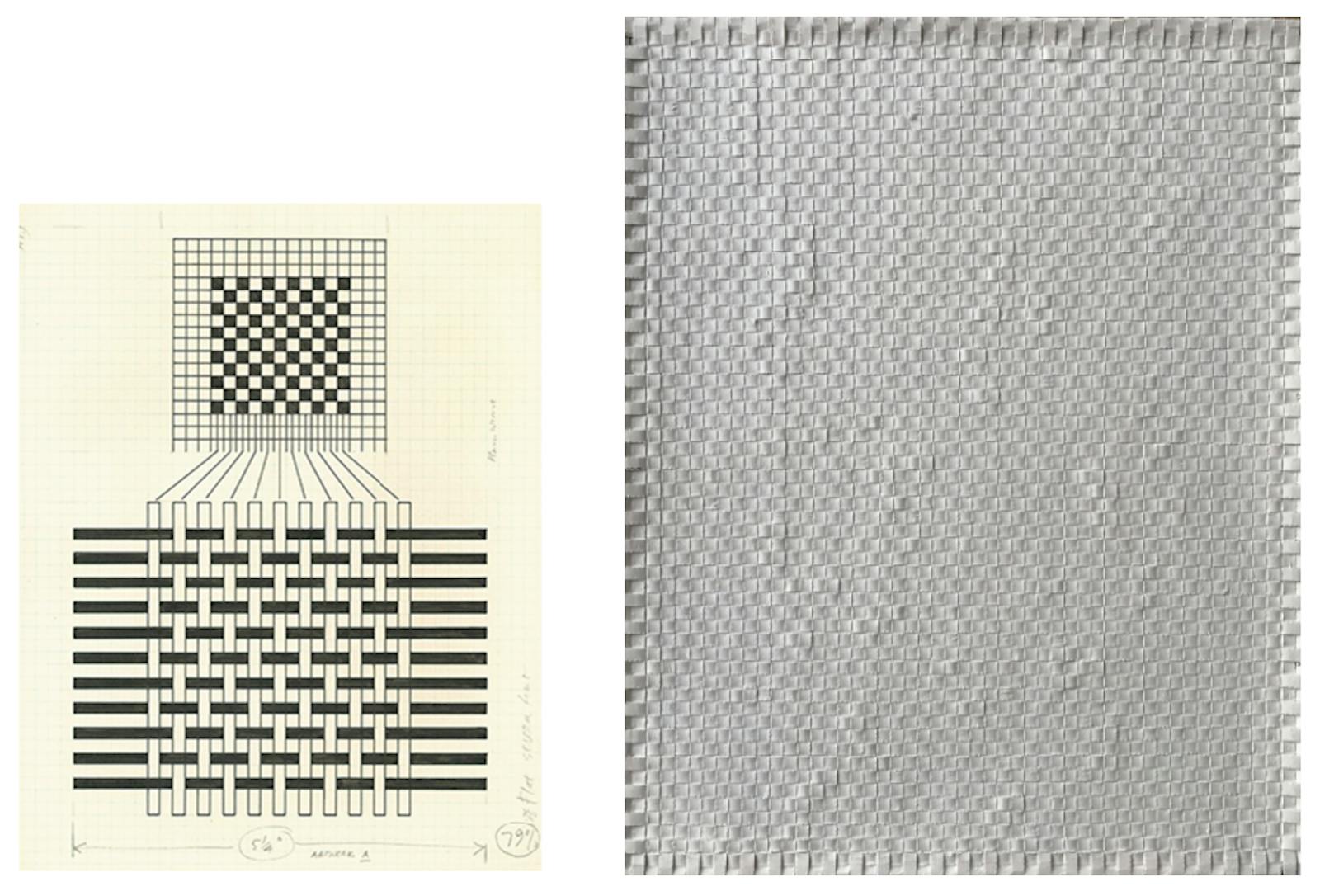
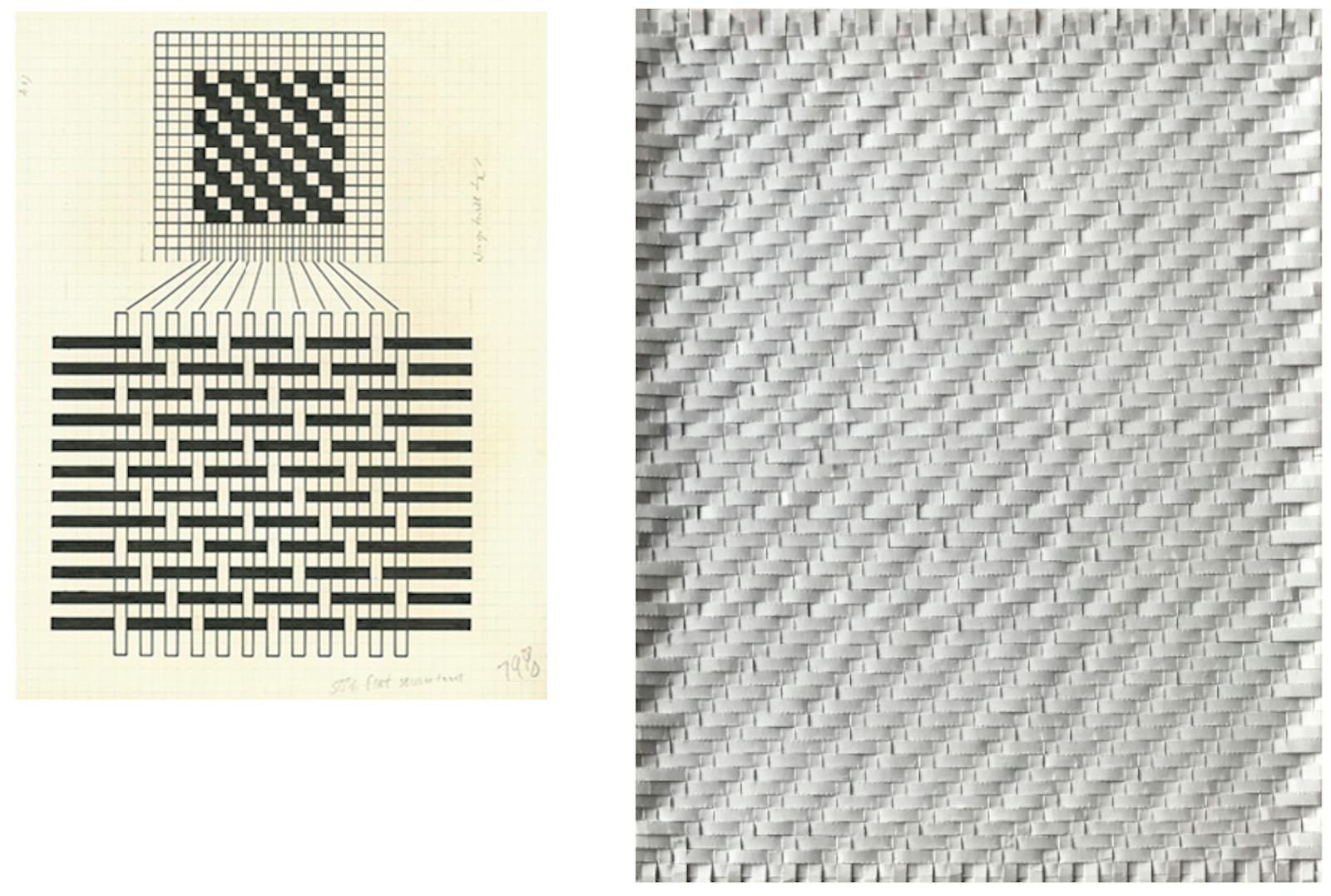
(above) Plain Weave Exercises, Ph.D. Research, First Year, Winter/Spring Term, 2018. (left) Anni Albers weaving notations from On Weaving / (right) Larissa Nowicki hand woven paper maquettes constructed from the margins of used books.
On Weaving—A Lesson in Simple Weaving.
“In the plain weave, this intersecting of warp and weft takes place in the simplest possible manner. A weft thread moves alternately over and under each warp thread it meets on its horizontal course from one side of the warp to the other; returning, it reverses the order and crosses over those threads under which it moved before and under those over which it crossed. This is the quintessence of weaving.” –Anni Albers, ‘The Fundamental Constructions’ in On Weaving
Taking lessons in weaving from Anni Albers while using my choice of material. Unlike the first practice experiment on the street this experiment took place in a studio space with my used books as the raw material to work with and my familiar tools used in hand to interpret her instructions.

(above) Interwoven Material, Ph.D. Research, First Year, Summer Term, 2018
Hand woven maquette blending my material (old book pages) with printed colour plates of Anni’s weavings pulled from my new copy of the latest edition of On Weaving.
There are many layers to unpack in my practice-led research so let me be clear. I am not conducting this research to produce artworks for an exhibition. The making is the site for thinking. It is a process by which I engage with Anni’s interdisciplinary concepts. It is the space in which I am participating in a silent dialogue with someone who is no longer physically with us. I am not researching textiles or it’s relationship to notions of text although it is natural to touch upon these ideas as I blend Anni’s concepts with my practice of deconstructing books for material application. Each individual project I make, with its own nuances and insights, is an engagement with the materiality of ideas.

(above) Untitled Ink Gestures, Ph.D. Research, Second Year, Autumn Term, 2018
“And this being-with spectres would also be, not only but also, a politics of memory, of inheritance, and of generations (...) If I am getting ready to speak at length about ghosts, inheritances, and generations, generations of ghosts, which is to say about certain others who are not present, nor presently living, either to us, in us, or outside us, it is in the name of justice.” –Jacques Derrida, Exordium
Night is my favourite time of day. London is deadly quiet, my friends in the USA are going to bed, the phone stops ringing and I’m left alone wondering if tonight is the night werewolves or vampires will make an appearance, because let’s face, all my days are spent with the ghost of Anni. I put weaving aside and play with the leftover scraps on my desk. My gestures from earlier exercises in making have been captured in streaks of old printer’s ink across my desk. I notice how these marks remain as a testament to the past in conversation with the present.
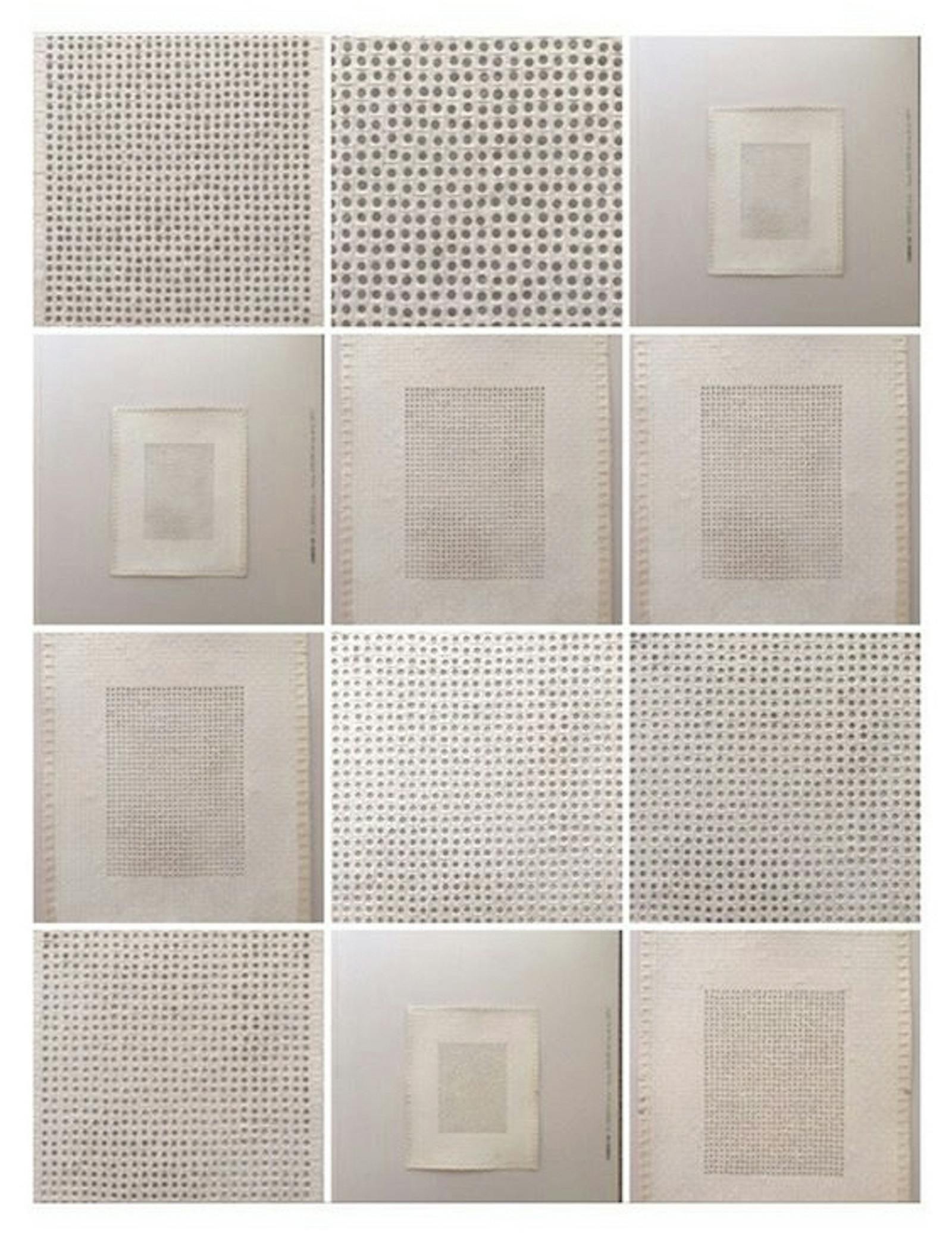
(above) Weaving in the Margins, Ph.D. Research, Second Year, Winter/Spring Term, 2019
“And just as it is possible to go from any place to any other, so also starting from a defined and specialised field, can one arrive at a realisation of ever-extending relationships.” –Anni Albers, preface On Weaving
A Graphic Design education steeped in Bauhaus theory has shaped the way my thinking is organised and how I negotiate being in the world. My research is a constant interplay between Anni Albers’s concepts and my fine art practice. However, there’s something that cannot be avoided—I am grappling with the way my knowledge in and around book design persists and will always inform my approach to thinking and making whether it be in design, art, or research. Thankfully, I’ve had great teachers and colleagues along the way. It’s all connected. It’s my “meshwork”.
“It is a field not of interconnected points but of interwoven lines; not a network but a meshwork”. –Tim Ingold, Being Alive
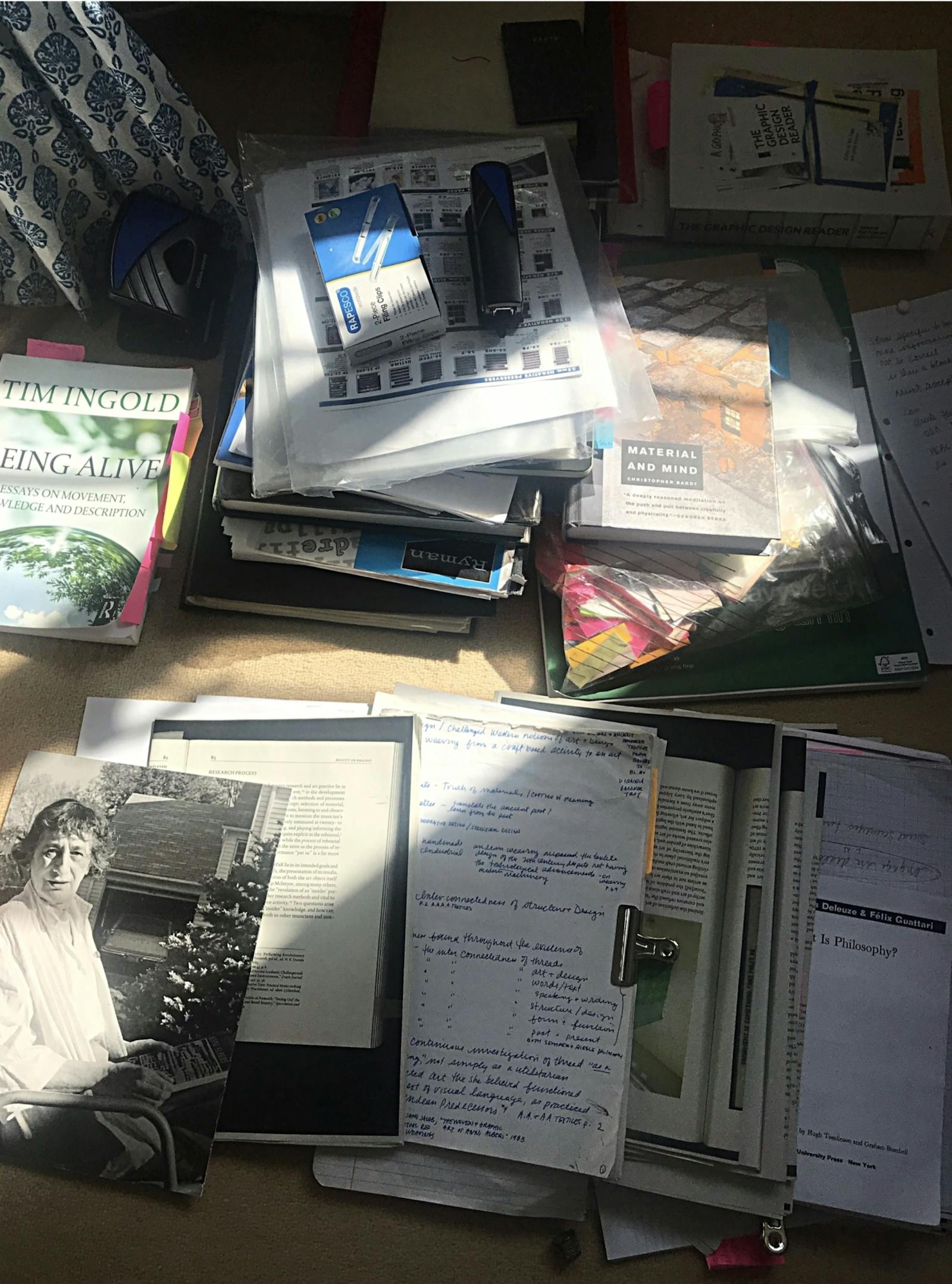
(above) Working from Home, Ph.D. Research at the onset of a global pandemic and London’s first lockdown, Third Year, Winter/Spring Term, 2020
“Our world goes to pieces; we have to rebuild our world (...) We have to find our strength rather than our weakness.” –Anni Albers, ’One Aspect of Art Work’ 1944 in Selected Writings on Design
I see you over there Anni, when I consider the house plants and think to move them into that ray of sunlight and when I contemplate organising my flat by moving the books and the office supplies from one side of the room to the other. This is the messy work of Ph.D. research in the time of a global pandemic, in lockdown; but who am I to complain or suggest that this is difficult? I proposed to get inside your words, to do what you say but how could I ever have imagined my research would take place under devastating conditions? Two months ago under challenges that seem minor compared with today, I said there would be no quitting—the Albers never had a choice to quit and home after emigrating to the USA to escape Nazi Germany—and so now I face greater challenges than battling the RCA for studio space. I will learn through the depths of my own experience in the face of a global crisis. I feel you Anni.

(above) Absence and Presence (detail of work-in-progress), Ph.D. Research during a global pandemic, Third Year, Summer into Autumn term, 2020
“Art is the final aim.” –Anni Albers, ‘Material as Metaphor’ 1982 the last published essay in Selected Writings on Design
With a return to autumn and a grounding in the Virgo sun the world is getting busy again and my summer of isolation, my summer of making is cast in the last few stitches. It’s a been a whirlwind week of socially distanced lectures, chats, meetings, interviews and walks in the park. Through it all I keep returning to Monday’s lecture with Sera Waters and her comments on the simple stitch—“it has the power to transform the world around us, to change culture, to change how we see ourselves”.

(above) Absence and Presence, Ph.D. Research during a global pandemic, Third Year, Summer into Autumn Term, 2020
The contribution to knowledge resides in the practice output.
Pictured above is my penultimate component of practice completed near to the culmination of my research. Here the dominant narrative of western art history is subverted by the simple stitch. Sometimes actions speak louder than words.

(above) Reflection, Ph.D. Research during a global pandemic, Fourth Year, Autumn Term, 2020
“Beginnings are usually more interesting than elaborations and endings. Beginning means exploration, selection, development, a potent vitality not yet limited, not circumscribed by the tried and traditional. For those of us concerned in our work with the adventure of search, going back to beginnings is seeing ourselves mirrored in others' work, not in the results but in the process.” –Anni Albers, On Weaving
…and so I’m nearing the end, I can feel there will be a stopping point—after an ending which takes me back to the beginning. Watch me as I do it again…

(above) Paradox, Ph.D. Research during a global pandemic, Fourth Year, Winter/Spring Term, 2021
paper
thread
text
image
knots
intention
meander
links
conversation
ethics
research
strategy
context
making
thinking
time
past
present
absence
presence
homage
reflection
The fine art practice, within this research, is an enquiry. It takes old ideas into consideration. It tests, tries, and responds. I observe, I listen, and then I do it again. The conversation, goes on, ongoing in hand through time, paper and thread. And sometimes, Anni makes herself known.
My research is greatly informed and inspired by my time spent in residence at the Josef and Anni Albers Foundation (Bethany, Connecticut) in 2012 and 2015. I would like to express my gratitude to the entire staff for their knowledge and friendship. To learn more about Anni Albers please visit the Josef and Anni Albers Foundation online at https://albersfoundation.org
To see more of my practice-led research and to follow the final outcome of these projects check in with me on Instagram where I’m documenting the practice as it unfolds in real time @larissanowicki
